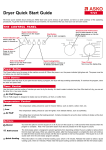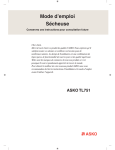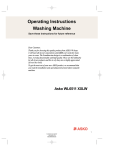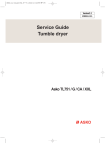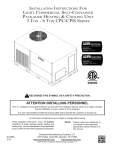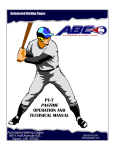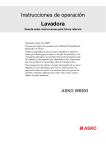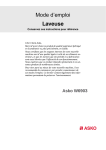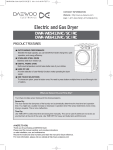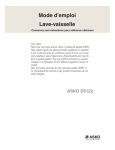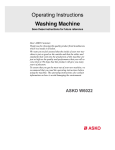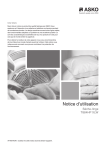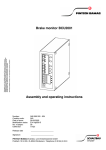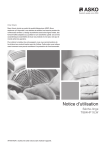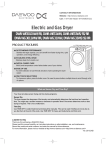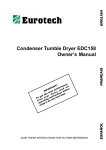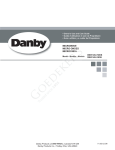Download Asko TL751XXL Operating Instructions
Transcript
Operating Instructions Tumble dryer Save these instructions for future reference Dear customer, Thank you for choosing this quality product from ASKO. We hope it will meet all of your expectations and fullfill your needs for many years to come. The Scandinavian design is a combination of clean lines, everyday functionality and high quality. These are the hallmarks for all of our products and this is why they are so highly appreciated all over the world. To get the most out of your new ASKO product, we recommend that you read the installation and operating instructions before using the machine. Asko TL751 XXLW 1 Customer Care Center 1-800-898-1879 www.askousa.com Contents Before using your machine for the first time Important safety instructions Grounding instructions Interrupting a program Transport/Winter storage Packing material Recycling Child safety Description of the tumble dryer Front panel Advice and tips before you tumble dry Have the clothes been spun? Laundry labels Do not tumble dry Operating instructions Selecting Settings Dry Sensor Temp Dry Time Signal Selecting Options Rack Dry More time/Less Time Damp Signal Anti-crease Delay Start Child Lock Care and maintenance instructions Cleaning the lint filter Cleaning the door and its opening Troubleshooting Guide My dryer won’t start My Dryer Doesn’t Heat There are greasy spots on my clothes My dryer displayed an error code There is lint on my clothes There is static in my clothes after drying The drying time is not consistent Water is found around the cabinet cover when opening the door It takes too long for my clothes to dry My clothes are wrinkled My clothes are shrinking 3 4 4 5 5 5 5 6 7 8 9 9 9 9 10 14 14 14 14 14 15 15 15 16 16 16 16 Technical information Technical data Service and guarantee Installation instructions Positioning the tumble dryer Connecting the exhaust system Electrical plug connections Preparation of the dryer Confirming heat source operation Dryer airflow Additional instructions for installation of your dryer in a manufactured or mobile home Electrical requirements User- maintenance instructions Reversing the Door Quick guide 17 17 17 18 18 18 18 18 19 19 19 19 20 20 20 2 Customer Care Center 1-800-898-1879 www.askousa.com 21 21 22 24 24 26 28 28 28 29 29 31 37 39 40 Before using your machine for the first time Do not tumble dry Certain materials are not suitable for tumble drying. Always check and follow the Instructions on each item’s laundry label. You can find more information in the “Advice and tips before you tumble dry" chapter. Note! When starting the tumble dryer for the first time or after a long period without use, you may hear a slight thumping noise. This noise is completely normal and will disappear after a few loads. See the Quick Guide on the last page. 3 Customer Care Center 1-800-898-1879 www.askousa.com Important safety instructions Warning! To reduce the risk of fire, electric shock, or injury to persons when using your appliance, follow basic precautions, including the following: • Read all instructions before using the appliance. • Do not run appliance while you are out of the home. • Do not wash or dry articles that have been previously cleaned in, washed in, soaked in, or spotted with gasoline, dry-cleaning solvents, cooking oils, or other flammable or explosive substances because they give off vapors that could ignite or explode. • Do not allow children to play on or in the appliance. Children should be closely supervised when near the appliance. • Before the appliance is removed from service or discarded, remove the door to the washing compartment. • Do not reach into the appliance if the drum is moving. • Do not install or store this appliance where it will be exposed to the weather. • Do not tamper with controls. • Do not attempt to repair or replace any part of the appliance or perform any servicng unless specifically recommended in this guide. • Do not use fabric softeners or dryer sheets unless the manufacturer gives written assurance that the product will not damage a tumble dryer. • Do not use heat-dry items containing: vinyl, plastic, foam rubber or similarly textured rubber-like materials fiberglass wool unless the label specifies “washable”. • Clean the lint filter before or after each load. • Keep the area around the exhaust opening and adjacent surrounding areas free from the accumulation of lint, dust and dirt. • The interior of the machine should be cleaned periodically by an authorized ASKO service agent. • Do not place items exposed to cooking oils in your dryer. Items contaminated with cooking oils may contribute to a chemical reaction that could cause a load to catch fire. • Electrical installation, if required, must be done by a licensed electrician. • Do not operate appliance while away from the home. • Do not heat dry items that have been drycleaned. • The dryer is made and marked to facilitate recycling. When it is no longer useful, contact your local refuse collection service for advice on how to properly dispose of the dryer for purposes of recycling. • Damaged power cables should only be replaced by a certified professional. • Provide sufficient ventilation, otherwise smoke from open fires or fumes from equipment burning other fuels can be drawn into the room. Caution! During the program, the back of he dryer will get very hot. Let the machine cool completely before touching the back. Warning! This appliance must be properly grounded. Grounding instruction A) Grounding instructions for a grounded, cord-connected appliance: In the event of malfunction or breakdown, grounding will reduce the risk of electric shock by providing a path of least resistance for electric current. This appliance (Canadian market only) is equipped with a cord having an equipment-grounding conductor and a grounding plug. The plug must be plugged into an appropriate outlet that is properly installed and grounded in accordance with all local codes and ordinances. ❋ Refer to Electrical requirements. 4 Customer Care Center 1-800-898-1879 www.askousa.com Important safety instructions To reduce the risk of fire, this appliance must be exhausted outdoors or the equivalent. Do not exhaust into a chimney, wall, ceiling or concealed space in a building. Packing material Please sort waste materials in accordance with local guidelines. Recycling Warning! Improper connection of the equipmentgrounding conductor can result in a risk of electric shock. Check with a qualified electrician or service representative or personnel if you are in doubt as to whether the appliance is properly grounded. Do not modify the plug provided with the appliance (Canadian market only). If it will not fit the outlet, have a proper outlet installed by a qualified electrician. This machine is manufactured and labeled for recycling. In order to prevent injuries, the machine must be made unusable once the decision has been taken to dispose of it. Contact your local authority for information about where and how your machine can be recycled correctly. B) Grounding instructions for a permanently connected appliance: This appliance must be connected to a grounded metal, permanent wiring system, or an equipment-grounding terminal or lead on the appliance. Note! This manual does not cover every possible condition and situation that may occur. Use common sense and caution when installing, operating, and maintaining any appliance. Interrupting a program You can stop a drying program by: • Opening the door. The drum will then stop automatically. • Pressing the main power switch. • You can also stop a program by pressing the Stop button. • When you want to resume tumble drying, close the door and press the Start button. • If a program has been interrupted for 10 minutes the program will be cancelled and the machine will turn itself off. You will then have to start the program over again. Customer Care Center 1-800-898-1879 www.askousa.com 5 Child safety Do not allow children to play with the Tumble dryer. The tumble dryer does not start automatically when the door closes (for example, if a child closes the door from inside). The tumble dryer has a door lock, which allows the door to be opened from the inside. The door has a door-switch that automatically stops the tumble dryer when the door is opened. 6 Customer Care Center 1-800-898-1879 www.askousa.com Description of the tumble dryer 1 1. Top plate 2. Program panel 3. Front cabinet 4. Lint filter holder 5. Fan (behind the front cabinet) 6. Adjustable leg 7. Glass door 8. Outer door 2 3 8 7 4 5 6 Accessories Dryer Rack Pedestal Purchased Separately ❈ Design of pedestals is subject to change without manufacturers notice. 7 Customer Care Center 1-800-898-1879 www.askousa.com Front panel 1 2 3 4 1. Power button 2. Program selector 3. Display window 4. Settings buttons 5. Options buttons 6. Start/Stop button 8 Customer Care Center 1-800-898-1879 www.askousa.com 6 5 Advice and tips before you tumble dry Here are some tips that may help you before you begin tumble drying. Have the clothes been spun? Items to be tumble dried should be spun at 1000 rpm or faster. Higher spin speeds save both energy and drying time. Do not tumble dry • materials labeled “Do not dry near heat”. • garments that have been dry-cleaned at home. • plastic foam. • fiberglass material. • wool must not be tumble dried due to the risk of piling. Laundry labels Note! Materials that can be tumble dried This symbol means that the material is suitable for tumble drying. Fabrics best suited to tumble drying are cotton fabrics, terry cloth, and synthetic fibers. Garments will be softer and lighter when tumbled than when hung out to dry. Note! The tumble dryer does not cause any significant wear to fabrics. The lint trapped in the lint filter consists of dust and fiber residues which gather when the items are used. Materials that should not be tumble dried This symbol means that the material is not suitable for tumble drying. Certain materials may melt or become a fire hazard if exposed to heat and others can lose their shape or shrink If the door is opened during the program, the program will be interrupted and will return to the start. The clothes may be too damp or too dry as a result. Warning! Fire Hazard No washer can completely remove oil. Do not dry anything that has ever had any type of oil on it (including cooking oils). Items containing foam, rubber, or plastic must be air dried. Failure to follow these instructions can result in death or fire. Explosion Hazard Keep flammable materials and vapors, such as gasoline, away from the dryer. Do not dry anything that has ever had anything flammable on it (even after washing). Failure to follow these instructions can result in death, explosion, or fire. 9 Customer Care Center 1-800-898-1879 www.askousa.com Operating instructions 1) Sensor Dry programs Warning! To reduce the risk of electric shock or injury to persons, read the “Important Safety Instructions” selection before operating this appliance. Below are step-by-step instructions to help you achieve the best possible tumble drying results. 1 Bulky items Sort your fabrics. You will achieve the most uniform drying results if the items are made of the same type of material. Close zippers and fasten button or belts; sort the items and adjust load and temperature. 2 3 4 Sensor Dry programs allow you to match the program to the load you are drying. Each program dries certain fabrics at the recommended temperature. A sensor detects the moisture in the load and automatically adjusts the drying time for optimal drying. Turn on the main power button. This program is used for drying heavy fabrics such as quilts and blankets. Towels This program is used for drying heavy fabrics such as towels, jeans, corduroys or work clothes. Everyday Wear This program is used for drying denims, towels, heavy cottons. Open the door, load the items, and then close the door. Synthetics This program is used for drying sturdy fabrics such as casual clothes. Select the program. Choose a program that is suitable for the type of load you are drying. Gentle This program is used for permanent pressed and synthetic items. Ultra Gentle This program used for drying synthetic fabrics, and no-iron finishes. Iron Dry This program is used for the load which is just damp enough for ironing or pressing. 10 Customer Care Center 1-800-898-1879 www.askousa.com Operating instructions Sensor Dry Preset Program Settings When using Air Dry This chart shows examples of items that can be dried using Air Dry. Sensor Dry Programs Load Type Temperature Time (Minutes) Bulky Items (Bulky, Heavy weight) High 55 Type of Load Towels (Jeans, Heavy weight) High 50 20 - 30 Everyday Wear (Towel, Denim pants) Foam rubber-pillows, padded bras, stuffed toys Mid. High Synthetics (Work clothes, Corduroys) 20 - 30 Medium 47 Plastic shower curtains, tablecloths Gentle (Synthetics, Permanent press) Rubber-backed rugs 40 - 50 Low 40 10 - 20 Ultra Gentle (Lingerie, Sheets, Blouses) Olefin, polypropylene, shear nylon Low 35 Iron Dry (Shear, Workout wear, Lace items) Ultra Low 35 Time (Minutes) 59 2) Manual Dry programs Use Manual Dry programs to select a specific amount of drying time and a drying temperature. When the manual dry program is selected, the estimated time remaining display shows the actual time remaining in your program. You can change the actual time in the program by pressing More Time or Less Time. Quick Dry • Check to see that coverings are securely stitched. • Shake and fluff pillows by hand periodically during the cycle. • Dry item completely. Foam rubber pillows are slow to dry. Manual Dry Preset Program Settings Manual Dry Programs Load Type Temperature Time (Minutes) Quick Dry (Small loads) High 30 Freshen (Remove wrinkles) Mid. High 30 Air Dry — 35 This program is used for small loads or loads that need less drying time. Freshen This program is used for removing wrinkles from items, such as clothes packed in a suitcase or items wrinkled from being left in the dryer too long.. Air Dry This program is used for items that require drying without heat such as rubber, plastic and heat-sensitive fabrics. Customer Care Center 1-800-898-1879 www.askousa.com 11 Operating instructions 5 Programed settings and options guide Cycles Bulky items Dry Sensor Temperature Default Normal High Select All X Default Normal High Select All X Default Normal Mid.High Select All X Default Normal Medium Select All X Default Normal Low Select All X Default Normal Low Select All X Default Damp dry Ultra low Select X X Default — High Select X Ultralow~high Default — Mid High Select X Ultralow~high Default — — Select X X Towels Everyday wear Synthetic Gentle Ultra gentle Iron dry Quick dry Freshen Air dry More Time Less Time Rack dry Anti crease Delay start Damp signal X O O X O O X O O X O O X O O X O O X O O O O X O O X O O X A.If you select Rack Dry,the previous course and operation will be cancelled. B.If you select Rack Dry,Anti-crease and Damp signal is not available. 12 Customer Care Center 1-800-898-1879 www.askousa.com Operating instructions 6 Press the Start button Cleaning the lint filter Remaining drying item The remaining drying time will be shown on the display. For example, 1:35 means it will take approximately 1 hour and 35 minutes for the load to dry. If the Anticrease option has been selected, the drum will rotate until you press the Power button or Start/Stop button. 1. Open the door and pull the filter straight up. Note! • The program will not be affected if you change the program selector after the program has started. • The program will continue from where the program was interrupted if you close the door and press the Start button within 10 minutes. If the program is interrupted for more than 10 minutes, the dryer will be shut off. Select new program settings before restarting the dryer. 2. The filter may need to be cleaned if it has lime-scale deposits. See the “Care and maintenance” chapter. 8 Once drying has finished Turn off the power switch. Remove the clothes and close the door to prevent small children from climbing into the machine. Loading or removing laundry If you want to load or remove laundry once you have started the machine, open the door and the program will stop. Add more laundry or take out the items you want, close the door, and press the Start/Stop button 7 Dry program finished The text “END” appears on the display when the program has ended. If the Anti-crease option has been selected, the drum will periodically rotate until you press Power button or Start/Stop button. Important! Clean the lint filter after each load. Caution! If the lint filter becomes clogged, the machine’s automatic overheating cut-off may be triggered. Customer Care Center 1-800-898-1879 www.askousa.com 13 Selecting Settings Signal The Signal controls the volume of the beep that is made when you press any of the buttons at the end of the cycle. Press Signal to adjust the sound level or turn off the signal. Dry Sensor • Use these buttons to set dry level. • First, select the Sensor Dry program. • Select dry level to adjust how much you want to dry the load. As the program runs, the control senses the dryness of the load and adjusts the time automatically based on the selected dryness level. Note! Dry Sensor selections can only be made while using the Sensor Dry programs. Selecting “more dry” or “less dry” automatically adjusts the preset times for the manual dry programs. Temp. Use the Temp. option to select temperatures for the Manual Dry programs. Press Temp. until the desired temperature setting glows. You can't change temperatures on sensor dry programs. Temperature is set by the program. Dry Time Use Dry Time option to change drying time per your preference. When choosing Dry Time, the temp is always set to "High" by default however temperature can be changed per your desire setting. You can select the desired operation time manually by pressing the Dry Time button between 20 to 60 minutes. 14 Customer Care Center 1-800-898-1879 www.askousa.com Selecting Options 3. Make sure the dry rack is setting evenly on the front and rear of the drum inside the machine. Rack Dry Rack Dry is designed to use for items which are not suitable for tumble drying such as sweaters, silk, lingerie. This option may be used for drying sneakers. Note! During the Rack Dry cycle, • Time remaining goes to 55min and no default temperature. • Only LOW and ULTRA LOW temperature can be selected. • MORE/LESS time can be used to change times. • ANTI CREASE and DAMP Signal option is disabled. 1. Open the door. Hold the dryer rack with both hands. Note! Don’t use the rack for normal tumble drying. The rack is shipped in place in your dryer. Please remove the rack before using this dryer for the first time. Suggested Items for Rack Drying Temperature Time Setting (Minutes) Washable wool items Low 20 Stuffed toys with cotton or polyester fiber filling Low/Ultra Low 20/30 Stuffed toys, foam rubber filled Air Dry/ Ultra Low 50/30 Foam rubber pillows Air Dry 50 Athletic shoes Air Dry 20 More Time / Less Time Press More Time or Less Time until the desired drying time is set. 2. Put the dryer rack into the drum. 15 Customer Care Center 1-800-898-1879 www.askousa.com Selecting Options Note! Important! Time change is available only with Manual dry, Dry Time and Rack dry programs. Remember to press the Start/Stop button to start the program. Damp Signal Child Lock * When you select the Damp Signal option, a beep will alert you when your load is just damp enough for ironing or pressing. This notice will allow you to remove lightweight items that are dried or other items that you may wish to iron. Anti-crease This option helps to prevent wrinkles on your laundry. When you select the Anti-crease option, the drum will periodically rotate until you press the Power button, Start/Stop button, or open the door. You can use this option in case you cannot remove laundry immediately after drying is done. The child lock option can be used to prevent a child from pausing or cancelling a dry program once it has been started. To set this option, you must first select a dry program and any desired options. Press the Start/Stop button to start the cycle. Next, press the Child lock button for 3 seconds to engage the Child lock option. Child lock will be lit up as long as the option is active. To cancel this mode, hold the Child lock button again for 3 seconds, and turn off the main power button. You will have to set the Child Lock option at the beginning of every cycle you choose to have protected. Estimated Time Remaining Delay Start When you select Delay Start, the machine will start between 1 and 12 hours after you press the Start/Stop button. • Press the Delay Start button the same number of times as the number of hours by which you want to delay the start (1~12 hours). • The number of hours of delay start you have selected will be shown in the display. • Press the Start/Stop button. • The number of hours to start is displayed with a countdown one hour at a time. • Cancel Delay Start by pressing power button and turning the machine off. • Turn the power back on, select a program and press the Start/Stop button. The display shows the estimated time remaining. In addition to this, if the dryer has some problem, it displays error messages. Refer to Trouble shooting guide. 16 Customer Care Center 1-800-898-1879 www.askousa.com Care and maintenance instructions Cleaning the lint filter Cleaning the door and its opening Clean the filter after each use and check it before use. Not cleaning or emptying the filter will increase drying time and energy consumption, potentially shortening the dryer life expectancy. 1. Wipe the door opening. Accumulations of lint or dirt may prevent the door from sealing properly. 1. Open the door and pull the filter straight up. 2. Clean the transparent glass door to keep inside view clear through the glass. 2. Clean the filter using one of the following methods. Run the fingers across the filter. Vacuum the lint filter. Wash the lint screen in warm, soapy water. Dry thoroughly and replace. 17 Customer Care Center 1-800-898-1879 www.askousa.com Troubleshooting guide Troubleshooting Tip! Save time and money! Review the charts on the following pages first and you may not need to call for service. 1. Problem: My dryer won’t start. Question • Is the dryer plugged in? What to Do Confirm that the dryer’s plug is securely and completely pushed into the laundry room’s power outlet. • Is the fuse blown, or is the circuit breaker tripped? Check your home’s or laundry room’s fuse box/circuit breaker box and replace the fuse or reset the circuit breaker. (IMPORTANT: electric dryers generally use two fuses or breakers.) 2. Problem: My Dryer Doesn’t Heat Question • Is the fuse blown, or is the circuit breaker tripped? What to Do If the fuse is blown or the circuit breaker tripped, the dryer might tumble but not heat. Check your home’s or laundry room’s fuse box/circuit breaker box and replace the fuse or reset the circuit breaker. (IMPORTANT: electric dryers generally use two fuses or breakers.) • Is the gas supply or service blocked or off? Confirm that the house gas shutoff and the dryer gas shutoff are both fully open. 3. Problem: There Are Greasy Spots On My Clothes. Question • Did you follow the instructions on your fabric softener product? What to Do Confirm and follow the instructions provided with your fabric softener product. • Are you drying clean and dirty clothes together? Make sure to use your dryer to dry only clean items, because dirty items can soil clean clothes placed in the same load or later placed in the dryer drum. • Were your clothes entirely clean? Stains on dried clothes are actually stains that weren’t cleansed during the washing process. Please review and confirm that you are following your washing instructions and that the clothes are being completely cleaned. 4. Problem: My Dryer Displayed An Error Code. Question H1 What to Do Is displayed when humidity sensor is error. In this case, power off and restart. H2 Is displayed when temperature sensor is error. In this case, power off and restart. H5 Heater temperature control problem. In this case, call servic center. 18 Customer Care Center 1-800-898-1879 www.askousa.com Troubleshooting guide 5. Problem: There Is Lint On My Clothes Question • Is your lint filter full? What to Do Please refer to the manual section on cleaning the lint filter, and please confirm that the lint filter is clean. It is important that the lint filter is clean before each new load of laundry. • Did you properly sort your load of laundry? In order to reduce the amount of lint in a load of laundry, sort lint producers (like a fuzzy white cotton towel) separately from clothes that might catch lint (such as a pair of black linen pants). • Do your clothes have excess static electricity? See comments below under. There Is Static In My Clothes After Drying. • Did you overload your dryer? Divide your larger load into smaller loads. • Did you place any paper, tissue, or other similar material in the load? Sometimes a person might forget to take a piece of paper or a tissue out of a pocket, and this paper, tissue, or similar material can cause excess lint in a load of laundry. Confirm that the pockets of pants, shirts, and other articles of clothing are empty before washing and drying. 6. Problem: There Is Static In My Clothes After Drying Question • Did you use fabric softener? What to Do Try using a fabric softener to reduce static electricity. • Did you over dry the load of laundry? Over-drying a load of laundry can cause a build up of static electricity. Try using a fabric softener or adjust your settings and use a shorter drying time. • Are you drying synthetic, permanent press and blends? These materials can cause static to build up in a load of dried clothes. Try using a fabric softener. 7. Problem: The Drying Time Is Not Consistent Question • Are you using consistent heat settings and consistent load sizes? What to Do The drying time for a load will vary depending on the heat setting, the type of heat used (electric, natural or LP gas), the size of the load, the type of fabrics, the wetness of the clothes and the condition of the exhaust ducts and lint filter. 8. Problem: Water Is Found Around The Cabinet Cover When Opening The Door. Question • Is water found around cabinet cover when opening the door? What to Do This is normal because this is condensed moisture by drying. 19 Customer Care Center 1-800-898-1879 www.askousa.com Troubleshooting guide 9. Problem: It Takes Too Long For My Clothes To Dry Question • Did you properly sort your loads of laundry? What to Do Separate heavy weight items from light weight items when creating loads. • Are you drying large loads of heavy fabrics? Heavy fabrics take longer to dry because they tend to retain more moisture. To help reduce and maintain more consistent drying times for large and heavy fabrics, separate these items into smaller loads of a consistent size. • Are the dryer controls properly set? Use the appropriate control settings for the type of load you are drying. • Is the lint filter clean before each new load of laundry? Please confirm that the lint filter is clean prior to each new load of laundry. • Are the exhaust ducts clear and properly configured? Confirm through review of the appropriate sections of this manual that the exhaust venting ductwork is properly configured. Confirm that the venting is free of obstructions. Confirm that the outside wall dampers are moving freely, that the dampers are not pushed in, and that nothing has been set against the dampers. • Is the fuse blown, or is the circuit breaker tripped? Check your home’s or laundry room’s fuse box/circuit breaker box and replace the fuse or reset the circuit breaker. (IMPORTANT: electric dryers generally use two fuses or breakers.) • Did you overload your dryer? Divide your larger load into a number of smaller loads. • Did you under load your dryer? If you are only drying a handful of items, add a few extra pieces to help ensure proper tumbling action. 10. Problem: My Clothes Are Wrinkled Question • Are you over drying your laundry? • Are you removing your laundry from the dryer soon after the drying cycle is complete? What to Do Over drying a load of laundry can lead to wrinkled clothes. Try a shorter drying time, and remove items while they still retain a slight amount of moisture. Remove your laundry from the dryer after the drying cycle ends and either hang or fold the items. 11. Problem: My clothes are shrinking Question • Are you following the care instructions for your garment? What to Do To avoid shrinkage, please carefully follow the care and use instructions for your garment, because some fabrics will naturally shrink when washed. Other fabrics can be washed but will shrink when dried in a dryer. 20 Customer Care Center 1-800-898-1879 www.askousa.com Technical information Technical data Height: 40 1/4'' (102.2 cm) Width: 27” (68.6 cm) Depth: 31 1/2" (80 cm) Weight: 129 lb (58.5 kg) Cylinder volume: 7.3 cu.ft. (54.6 gal, 207 l) Max. drying capacity: 22.9 lb (10.4 kg) Speed: 48 rpm Rated power: See the rating label regarding detailed information. Drum material: Stainless steel Outer casing material: Powder-coated and hot-galvanized sheet steel Setup Freestanding 21 Customer Care Center 1-800-898-1879 www.askousa.com Service and guarantee Asko Appliances Inc. will not pay for: Service calls to: 1. Correct the installation of the appliance. 2. Repair damage due to shipment, delivery, installation, misuse or abuse. 3. Instruct how to use the appliance. 4. Replace house fuses or correct house wiring. 5. Correct house plumbing, including drainage problems related to improper installation. 6. Clean or service air device in drain line. • Repair and/or replacement parts for failure of product if appliance is used for other than home/residential use. • Damage resulting from accident, fire, floods, acts of God, alteration, misuse, abuse, improper installation, or installation not in accordance with local electrical or plumbing codes. • Any shipping costs for parts during the limited warranty period. • Replacement parts or repair labor costs for units operated outside the continental United States. • Pickup and delivery. ASKO washers are designed to be repaired in the home. For warranty service, contact our Customer Care Center at the number listed below. Before calling for service or contacting Asko Appliances Inc. regarding a warranty issue, make a note of the model, type name, and serial number. Write to us at: Asko Appliances Inc. P. O. Box 851805 Richardson, Texas 75085-1805 www.askousa.com Or contact our Customer Care Center at 1-800-898-1879 www.askousa.com In no event shall Asko Appliances Inc. be responsible for any incidental or consequential damages. Some states will not allow the exclusion or limitation of incidental or consequential damages, so this exclusion or limitation may not apply to you. This warranty gives you specific legal rights and you may also have other rights which vary from state to state. 22 Customer Care Center 1-800-898-1879 www.askousa.com Service and guarantee It is important to register your product warranty by logging onto www.askousa.com /customercare/registration and filling out all required fields within 90 days from the date of purchase. After doing so, you will be e-mailed a certificate that will extend the original warranty for one additional year. If you do not have access to the internet, complete the warranty card included with the product and mail it to the address on the warranty card within 90 days of the date of purchase. Cosmetic damage must be reported to your dealer within five days from the date of purchase. After unpacking the washer, thoroughly check the unit for cosmetic damage. For residential installations only Asko Appliances Inc. will pay for: Length of warranty Two-Year Full From date of purchase. ASKO replacement parts and/or repair labor to correct defect in materials or workmanship. Service must be provided by an authorized ASKO service agent. Third year full ASKO replacement parts and/or repair labor to correct defect in materials or workmanship. Service must be performed by an authorized ASKO service agent. Complete your product warranty registration online at www.askousa.com/customercare/registration within 90 days from the date of purchase to extend the original warranty one additional year. If you do not have access to the internet, complete the warranty card included with the product and mail it to the address on the warranty card within 90 days of the date of purchase. Lifetime ASKO replacement parts (labor cost not included) for the stainless steel tank if it exhibits a manufacturing defect such as cracking or rusting through. Service must be provided by an authorized ASKO service agent. For non-residential installations One-year full warranty from date of purchase ASKO replacement parts and/or repair labor to correct defect in materials or workmanship. Service must be provided by an authorized ASKO service agent. 23 Customer Care Center 1-800-898-1879 www.askousa.com Installation instructions The following instructions will guide you through the initial steps of setting up your dryer. Please note that every section of this manual provides important information regarding the preparation and use of your dryer, and it is important that you review this entire manual before proceeding with any installation or use. More detailed instructions concerning electrical connections, gas connections, and exhaust requirements are provided in other parts of this manual. Note! Leveling legs should be secured. All four legs should be stable placed on a solid and even floor. If dryer is not level, laundry may not tumble properly and sensor will not detect humidity information accurately. When leveling, please be cautious not to injure your fingers and toes. If you install the dryer on the optional pedestal, it is necessary to level with the pedestal leveling legs. Step 1. Positioning the tumble dryer Choose a location with a solid floor for your dryer. Place the dryer in the desired location and please make sure that it has the required clearances shown below. 52 1/2" (133.3cm) 40 1/4" (102.2cm) 27 (68.6cm) 31 1/2" (80cm) • Most installations require a minimum 6" (15.2 cm) clearance behind the dryer for the exhaust vent with elbow. 24 Customer Care Center 1-800-898-1879 www.askousa.com Installation instructions Minimum clearances on above, behind, and sides of the unit, as shown below, are required. Those required minimum clearances are set forth in the picture below. Please keep the following instructions in mind when installing in a closet or recessed area: • Consider allowing additional clearance for installation and servicing. • Wall, door and floor molding may necessitate additional clearances. • Additional inches of clearance are recommended to reduce noise while operating. • Consider the space needed for companion appliances. • For closet installations, the picture below shows the minimum required ventilation openings for the door. • A louvered door with comparable ventilation openings is also acceptable. 1/2" (1.2cm) 27" (68.6cm) 1/2" (1.2cm) Closet-Front View Once in position, adjust the leveling legs of the dryer until it is level from left to right and front to back. Be sure to tighten the leveling leg lock nuts against the bottom of the dryer. The leveling legs must remain firmly on the floor and the dryer should not rock. The maximum slope of the dryer from left to right or front to back should not exceed 1” (2.5 cm). If the dryer is not level, and if the slope exceeds 1” (2.5 cm), a load may not tumble properly and internal sensors may malfunction. Note! Closet Door 14" max (35.6 cm) 31 1/2" 1" (80cm) (2.54 cm) 18" (45.72 cm) Other sections of this manual also provide important information concerning the placement of and clearances for your dryer. Please review this entire manual before proceeding with any installation. 6" (15.2 cm) Closet Side View 25 Customer Care Center 1-800-898-1879 www.askousa.com Installation instructions Step 2. Connecting the exhaust system Warning! • To reduce the risk of fire this appliance MUST BE EXHAUSTED OUTDOORS. • The appliance should not be exhausted into a chimney, a wall, a ceiling, or a concealed space of a building. • Only rigid or flexible metal duct should be used, for exhausting. • Do not use plastic or thin foil duct unless it is UL certified. • Failure to follow these instructions can result in death or fire. • Clean old ducts before installing this dryer. Warning! The exhaust must be vented to the outside. Improper taping and incorrect installation will cause dryer malfunction. In addition to the above warnings, please refer to manual section on Exhaust Requirements and Maintenance. Important! To reduce the risk of fire, combustion, and gas accumulation, the dryer must be vented to the outdoors. Please follow the instructions (and all others in this manual) very carefully. • Do not use plastic or thin foil duct unless it is UL certified. • Use 4" (10.2 cm) diameter rigid or semi-rigid metal duct (NOTE! Venting materials are not supplied with the dryer, and you should obtain the venting materials necessary for proper installation) • Position the dryer such that the exhaust duct run is as short as possible. Clean old ducts before installing this dryer • The male end of each section of exhaust duct must point away from the dryer. • Use as few elbow joints as possible. • Use duct tape on all duct joints. • Insulate ductwork that runs through unheated areas in order to reduce condensation and lint build-up on pipe walls. PLEASE BE AWARE THAT FAILURE TO EXHAUST THE DRYER CORRECTLY WILL VOID THE DRYER’S WARRANTY. 26 Customer Care Center 1-800-898-1879 www.askousa.com Installation instructions Alternate exhaust directions 1. Insert the 90° Elbow (4") into the end of the exhaust duct on the rear panel in the correct direction. 3. Push the 90° elbow and the extension duct in place after aligning holes correctly and tape every connection. DUCT TAPE 2. Connect the straight exhaust duct into the end of the 90° Elbow (4"). 27 Customer Care Center 1-800-898-1879 www.askousa.com Installation instructions Step 3. Electrical plug connections The following steps are several warnings and instructions concerning making the electrical connection for electric dryers. More detailed information concerning the electrical connection is provided in the manual section entitled Electrical Requirements for Electric Dryer. It is important that you thoroughly review that section and the remainder of this manual, before taking any steps to install or use this dryer. 1. Use only a new UL listed No. 10 (copper wire only) three or four conductor power supply cord kit rated 240 Volts (minimum) 30 Amperes and labeled as suitable for use in a clothes dryer. 2. A four-wire cord is required for manufactured (mobile) home installations and where local codes do not allow grounding of this appliance through neutral. 3. Electrical Plug Connections. 4. For additional instruction on connecting the dryer to an electrical power source, please refer to this manual's section on Electrical Requirements and Electric Dryer. • See installation instructions for complete instructions. • Failure to do so may result in fire or electrical shock. Step 4. Preparation of the dryer Prior to the first use of this appliance, use all purpose cleaning products or a solution of detergent and water, with damp cloth to remove from the inside of the dryer drum/drying compartment any dust or dirt that may have accumulated inside the dryer. Plug-in your dryer after reviewing the following parts on your dryer’s Electrical Requirements. Step 5. Confirming heat source operation Confirming heat source in electric dryers After completing all steps in this manual for a proper installation, close the door on the dryer and start a dry cycle with heat. The exhaust air or the exhaust pipe should be warm after the dryer has been operating for three minutes. Warning! • Use a new UL listed 30 amp power supply cord. • Use a UL approved strain relief. • Disconnect power before making electrical connections. • Connect neutral wire (white or center wire) to center terminal. • Ground wire (green or bare wire) must be connected to green ground connector. • Securely tighten all electrical connections 28 Customer Care Center 1-800-898-1879 www.askousa.com Installation instructions Step 6. Dryer airflow Effective dryer operation requires appropriate dryer airflow. The adequacy of the airflow can be measured by evaluating the static pressure. Static pressure in the exhaust duct can be measured with a manometer, placed on the exhaust duct approximately 1 ft. (30.5 cm) from the final outlet. Static pressure in the exhaust duct should not exceed 7.6 mm water column. The dryer should be checked while the dryer is running with no load. Measuring Static pressure Manometer Home Construction and Safety Standards and local codes and ordinances. If you are uncertain whether your proposed installation will comply with these standards, please contact a service and installation professional for assistance. The following instructions apply to any installation of the dryer in a manufactured or mobile home: 1) The electrical connection for an electric dryer must be a 4-wire connection. More detailed information concerning the electrical connection is provided at the manual section entitled Electrical Requirements for Electric Dryer. 2) To reduce the risk of combustion and fire, the dryer must be vented to the outside. 3) Electric dryers may be vented to the outside using the back, left, right, or bottom panel. Exhaust Duct MAXIMUM STATIC PRESSURE IN WATER COLUMN 7.6mm Step 7. Additional instructions for installation of your dryer in a manufactured or mobile home The following instructions are applicable to installations of the dryer in a manufactured or mobile home. Any installation in a manufactured or mobile home must comply with the Manufactured 4) The dryer exhaust duct must be affixed securely to the manufactured or mobile home structure, the exhaust duct must be made of a material that will resist fire and combustion, and it is recommended that you use a rigid or flexible metal pipe. 5) DO NOT connect the exhaust duct with any other exhaust duct, vent, or chimney. 6) Make sure the dryer has adequate access to outside fresh air to ensure proper operation. The opening for outside fresh air must be at least 25 sq. inches (163 cm2). 7) It is important that the clearance of the duct from any combustible construction be at least 2 inches (5 cm), and, when venting the dryer to the outdoors, the dryer can be 29 Customer Care Center 1-800-898-1879 www.askousa.com Installation instructions installed with a clearance of 1/2” (1.2cm) at the sides and back of the dryer. 8) Please be aware that venting materials are not supplied with the dryer. You should obtain the venting materials necessary for proper installation. Warning! DO NOT connect exhaust ducts with metal screws or fasteners that extend into the duct. DO NOT vent the exhaust duct under the manufactured or mobile home. The following are additional instructions regarding electrical connections and requirements for electric dryers. Important Warning! To help prevent fire, electric shock, serious injury or death, the wiring and grounding must conform to the latest edition of the National Electrical Code, ANSI/NFPA 70 and all applicable local regulations. Please contact a qualified electrician to check your home’s wiring and fuses to ensure that your home has adequate electrical power to operate the dryer. 120V/240V, 60 Hertz, 3-wire installation Instructions for grounding of your electric dryer: a) This dryer must be connected to a grounded metal, permanent wiring system or an equipment-grounding conductor must be run with the circuit conductors and connected to the equipment-grounding terminal or lead on the dryer. b) The dryer has its own terminal block that must be connected to a separate 60 Hertz single phase AC circuit, fused at 30 Amperes (the circuit must be fused on both sides of the line). ELECTRICAL SERVICE FOR THE DRYER SHOULD BE OF MAXIMUM RATE VOLTAGE LISTED ON THE NAMEPLATE. DO NOT CONNECT DRYER TO 110, 115, OR 120 VOLT CIRCUIT. c) If branch circuit to dryer is fifteen feet (4.50 m) or less in length, use U.L. (Underwriters Laboratories) listed No. 10 A.W.G. wire (copper wire only), or as required by local codes. If over fifteen feet (4.50 m), use U.L. (Underwriters Laboratories) listed No. 8 A.W.G. wire (copper wire only), or as required by local codes. Allow sufficient slack in wiring so dryer can be moved from its normal location when necessary. d) The power cord (pigtail) connection between wall receptacle and dryer terminal block IS NOT supplied with dryer. Type of pigtail and gauge of wire must conform to local codes and with instructions mentioned on the following pages. e) The method of wiring the dryer is optional and subject to local code requirements. Refer to examples on next page. f) You must select the method by which to wire your dryer according to local code and ordinance requirements. Sample methods are included in the following pages. 30 Customer Care Center 1-800-898-1879 www.askousa.com Electrical requirements Review the following options to determine the appropriate electrical connection for your Home: Use the instructions in this section if your home has a 4-wire receptacle (NEMA type 14-30R) and you will be using a UL listed, 120/240V 30amp, dryer power supply cord. Use the instructions in this section if your home has a 3-wire receptacle (NEMA type 10-30R) and you will be using a UL listed, 120/240V 30amp, dryer power supply cord. 4-wire receptacle (NEMA type14-30R) 3-wire receptacle (NEMA type10-30R) If this type is available at your home, you will be connecting to a fused disconnect or circuit breaker box. If this type is available at your home, you will be connecting to a fused disconnect or circuit breaker box. 3-wire direct 4-wire direct 31 Customer Care Center 1-800-898-1879 www.askousa.com Electrical requirements 4-wire connection: Direct wire Important! Grounding through the neutral conductor is prohibited for (1) new branch-circuit installations, (2) mobile homes, (3) recreational vehicles, and (4) areas where local codes prohibit grounding through the neutral conductor. Prepare minimum 5 ft (1.52 m) of length in order for dryer to be replaced. First, peel 5” (12.7 cm) of covering material from end. Strip 5 inches of ground wire insulation. After cutting 1 1/2” (3.8 cm) from 3 other wires peel insulation back 1” (2.5 cm). Make ends of 3 wires a hook shape. 3. Make sure that the strain relief screw is tightened. Be sure that all terminal block nuts are on tight and power cord is in the correct position. Then, put the hooked shape end of the wire under the screw of the terminal block (hooked end facing rightward) and pinch the hook together and tighten the screw securely. 1. Connect neutral wire (white) of power cord to center terminal block screw. 2. Connect red and black wires to the left and right terminal block screws. 32 Customer Care Center 1-800-898-1879 www.askousa.com Electrical requirements tightened. Be sure that all terminal block nuts are on tight and power cord is in the correct position. 3-wire connection : Direct wire Important! Grounding through the neutral conductor is prohibited for (1) new branch-circuit installations, (2) mobile homes, (3) recreational vehicles, and (4)areas where local codes prohibit grounding through the neutral conductor. Prepare minimum 5 ft (1.52 m) of length in order for dryer to be replaced. First, strip 3 1/2” (8.9 cm) of outer sheath from end and strip 1” of insulation from each conductor. Then, put the hooked shape end of the wire under the screw of the terminal block (hooked end facing rightward) and pinch the hook together and tighten the screw securely. 1. Connect neutral wire (white) of power cord to center terminal block screw. 2. Connect red and black wires to the left and right terminal block screws. 3. Make sure that the strain relief screw is 33 Customer Care Center 1-800-898-1879 www.askousa.com Electrical requirements Option 1: 4-wire connection with a power supply cord • lf your local codes or ordinances do not allow the use of a 3-wire connection, or you are installing your dryer in a mobile home, you must use a 4-wire connection. 1. Connect neutral wire (white) of power cord to center terminal block screw. 2. Connect red and black wires to the left and right terminal block screws. 3. Connect ground wire (green) of power cord to external ground screw and move neutral ground wire of appliance and connect it to center screw. 4. Make sure that the strain relief screw is tightened. Be sure that all terminal block nuts are on tight and power cord is in the correct position. 34 Customer Care Center 1-800-898-1879 www.askousa.com Electrical requirements Option 2: 3-Wire connection with a power supply cord lf your local codes or ordinances permit the connection of a frame-grounding conductor to the neutral wire, use these instructions. If your local codes or ordinances do not allow the connection of a frame-grounding conductor to the neutral wire, use the instructions under Section 1: Optional 3- wire connection. Section 1 Option 3: Optional 3-wire connection • If your local codes or ordinances do not allow the connection of a frame-grounding conductor to the neutral wire, use the instructions under this section. 1. Connect neutral wire (white) of power cord to center terminal block screw. 2. Connect ground wire of appliance and neutral wire of power cord to center terminal block screw. 3. Connect red and black wires to the left and right terminal block screws. 4. Make sure the strain relief screw is tightened. Be sure that all terminal block nuts are on tight and power cord is in the correct position. 5. Connect independent ground wire from external ground connector to proper ground. 35 Customer Care Center 1-800-898-1879 www.askousa.com Electrical requirements The following are important instructions and information concerning the exhaust requirements for your dryer. Important Warning! To reduce the risk of fire, electric shock, or injury to person, read the IMPORTANT SAFETY INSTRUCTIONS before operating this appliance. To reduce the risk of fire, combustion, or accumulation of combustible gases, DO NOT exhaust dryer air into an enclosed and unventilated area, such as an attic, wall, ceiling, crawl space, chimney, gas vent, or concealed space of a building. To reduce the risk of fire, DO NOT exhaust the dryer with plastic or thin foil ducting. Weather Hood Type Recommended Use Only for Short RunInstallations Maximum length of 4” Number of (10.2 cm) diameter rigid 90° Elbows metal duct Maximum length of 4” (10.2 cm) diameter flexible metal duct 0 65 feet (19.8 m) 45 feet (13.7 m) 1 55 feet (16.8 m) 35 feet (10.7 m) 2 47 feet (14.3 m) 30 feet (9.1 m) 3 36 feet (11.0 m) 25 feet (7.6 m) 4 28 feet (8.5 m) 20 feet (6.1 m) 0 55 feet (16.8 m) 35 feet (10.7 m) 1 47 feet (14.3 m) 27 feet (8.2 m) 2 41 feet (12.5 m) 21 feet (6.4 m) 3 30 feet (9.1 m) 17 feet (5.2 m) 4 22 feet (6.7 m) 15 feet (4.5m) Note! Deduct 6 feet (1.8 m) for each additional elbow. It is not recommended to use more than 4 90° elbows. 36 Customer Care Center 1-800-898-1879 www.askousa.com User-maintenance instructions Exhaust requirements and instructions: 1. Venting materials are not provided with the dryer and you should obtain the necessary venting materials. For example, the outer end of exhaust pipe must have a weather hood with hinged dampers to prevent back draft when the dryer is not in use. 2. The exhaust duct must be four inches (10.2 cm) in diameter with no obstructions. The exhaust duct should be kept as short as possible. Make sure to clean any old ducts before installing your new dryer. 3. Rigid or semi-rigid metal ducting is recommended for use as transition ducting between the dryer and the wall. In special installations when it is impossible to make a connection with the above recommendations, then a UL-listed flexible metal transition duct may be used between the dryer and wall connection only. The use of this ducting will affect dry time. 4. DO NOT use sheet metal screws on exhaust pipe joints or other fastening means which extend into the duct that could catch lint and reduce the efficiency of the exhaust system. Secure all joints with duct tape. 5. To maximize operating results, please observe the duct length limitations noted in the chart on page 36. Exhaust and dryer maintenance necessary. 2. Before one year of use, when drying performance has become unsatisfactory, please examine and clean the exhaust duct for better drying performance. 3. Check the weather hoods frequently to ensure the dampers are moving freely, that the dampers are not pushed in and that nothing has been set against the dampers. 4. A qualified service person or company should be used to perform this maintenance. 5. Ordinarily, the dryer drum will need no care. Wipe the exterior of the dryer as required, and always wipe the exterior of the dryer in the event any detergent, bleach, or other washing products is spilled on the dryer. 6. Clean the control panel with a damp cloth as necessary. Warning: spray pre-wash products may damage the finish of the control panel. 7. Please clean the lint filter either before drying each load or after drying each load. 8. Always make sure the lint filter is clean before starting a new load, because a clogged lint filter may increase drying times. 9. Please note that the wiring diagram is provided inside the dryer control hood. Label all wires prior to disconnection when servicing the dryer, because wiring errors can cause serious injury to you and your dryer. Warning! Disconnect the dryer’s electric power prior to any cleaning or maintenance. 1. After one year of use, the interior and complete exhaust system of the dryer should be examined and cleaned if 37 Customer Care Center 1-800-898-1879 www.askousa.com Exhaust requirements and maintenance Cleaning the lint screen 1. Clean the lint filter once either before or after drying each load. Always make sure the lint filter is clean before starting a new load, because a clogged lint filter may increase drying times. 2. To clean, pull the lint screen straight up and roll any lint off the screen with your fingers. 3. Always ensure the lint screen is firmly secured before running the dryer. Running the dryer with a loose lint screen may cause overheating and damage to the dryer and articles being dried. 4. Some articles may shed more lint than others, causing the lint screen to fill rapidly. Remove lint from the lint screen before and after drying these articles, such as new towels. 5. In the event lint falls off of the lint screen and into the dryer during removal, inspect the exhaust hood and remove any lint. 6. Laundry detergent and fabric softener residue can build up on the lint screen, causing longer drying times. The screen is likely blocked if lint falls off the screen. In order to prevent this type of build up, and help ensure proper operation of your dryer, clean the lint screen with a nylon brush every six months or more frequently, if necessary. The lint filter can also be washed as follows: a) After rolling the lint off of the screen with your fingers, wet both sides of the screen with hot or warm water. b) Wet a nylon brush with hot water and liquid detergent and scrub the lint screen with the brush to remove the buildup of detergent and fabric softener. c) After the residue has been removed, rinse screen with hot water. d) After drying the lint screen with a clean 38 Customer Care Center 1-800-898-1879 www.askousa.com towel, firmly replace the lint screen in your dryer. Reversing the door Door hanging The tumble dryer come with the door hinged on the right. However, it is possible to change the door to be hinged on the left. 5. Next insert the hinge of the door securely in place of the left side of the front cabinet. Following these instructions: 1. Open the door and remove the two bolts holding the hinge. 6. Secure the hinge using the bolts you removed in step 1. 2 2. Then remove the door out of the front cabinet as indicated by the arrows. 1 3. Unscrew the four screws on the door lock on the left side of the front cabinet and move to the right side. 4. Replace the screws you removed in step 3. 39 Customer Care Center 1-800-898-1879 www.askousa.com Quick guide 1 Sort your Fabrics 2 3 4 Turn on the main power button • Dry fabrics of the same type together to ensure they dry as evenly as possible. 5 Press the Start/Stop button 6 Drying program finished 7 Once tumble drying has finished Open the door, load the items and then close the door Select a program • Turn the program selector to the desired program. • Select additional options per your desire. 40 Customer Care Center 1-800-898-1879 www.askousa.com • The text “END” appears on the display when the program has ended. If you have selected the Anticrease option, the drum will periodically rotate until you press the Power button or Start/Stop button. • Clean the lint filter after each load. • Open the door and remove the laundry. • If you have children or small pets, close the dryer door.










































